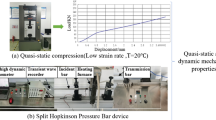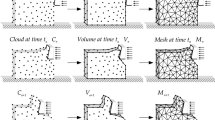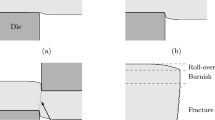Abstract
This contribution presents the model of a ‘granular solid’ based on the Discrete Element Method which is used to model cutting processes of cohesive and ductile materials, e.g. aluminum. The model is based on a conventional three-dimensional Discrete Element approach which employs rigid spheres as it is used to model granular media. Including cohesive interactions besides the repulsive interactions of the basic model allows for the particle agglomerate to display cohesive and ductile behavior. Using the thus generated granular solid the failure modes of ductile engineering materials like aluminum can be qualitatively and quantitatively reproduced. This is shown by comparison with experiments of a tensile and a Charpy impact test. To show the applicability of the approach for manufacturing problems an orthogonal cutting process of steel and aluminum is modelled and the cutting forces are compared to experiments. To further enhance the model thermal interactions between particles are included. The thermodynamics during cutting due to dissipative phenomena is evaluated and compared to experiments.
Similar content being viewed by others
References
Cundall PA (2009) A computer model for simulating progressive, large-scale movements in blocky rock systems. In: Proceedings of the Symposium of the International Society of Rock Mechanics, vol 1:II-8
Cundall PA, Strack ODL (1979) A discrete numerical model for granular assemblies. Géotechnique 1: 47–65
Fleissner F (2010) Parallel object oriented simulation with Lagrangian particle methods. Doctoral thesis, Institute of Engineering and Computational Mechanics, University of Stuttgart, Shaker, Aachen
Williams J, Perkins E, Cook B (2004) A contact algorithm for partitioning n arbitrary sized objects. Eng Comp 21: 235–248
Jing L, Stephansson O (2007) Fundamentals of discrete element methods for rock engineering: theory and applications, vol 85 of developments in geotechnical engineering. Elsevier, Amsterdam
Luding S (1998) Die Physik kohäsionsloser granularer Medien (in German). Logos, Berlin
Cundall P, Hart R (1992) Numerical modelling of discontinua. Eng Comp 9: 101–113
Lankarani HM, Nikravesh PE (1990) A contact force model with hysteresis damping for impact analysis of multibody systems. J Mech Des 112: 369–376
Kuwabara G, Kono K (1987) Restitution coefficient in a collision between two spheres. Jpn J Appl Phys 26: 1230–1233
Schäer J, Dippel S, Wolf DE (1996) Force schemes in simulations of granular materials. J Phys I France 6: 5–20
Fleissner F, Gaugele T, Eberhard P (2007) Applications of the discrete element method in mechanical engineering. Multibody Syst Dyn 18: 81–94
D’Addetta GA, Ramm E (2006) A microstructure-based simulation environment on the basis of an interface enhanced particle model. Granul Matter 8: 159–174
Liu K, Gao L, Tanimura S (2004) Application of discrete element method in impact problems. JSME Int J Ser A 47: 138–145
Bagi K (2005) An algorithm to generate random dense arrangements for discrete element simulations of granular assemblies. Granul Matter 7: 31–43
Jerier JF, Imbault D, Donze FV, Doremus P (2009) A geometric algorithm based on tetrahedral meshes to generate a dense polydisperse sphere packing. Granul Matter 11: 43–52
Cui L, O’Sullivan C (2003) Analysis of a triangulation based approach for specimen generation for discrete element simulations. Granul Matter 5: 135–145
Gaugele T, Fleissner F, Eberhard P (2008) Simulation of material tests using meshfree Lagrangian particle methods. Proc Inst Mech Eng Part K J Multi-body Dyn 222: 327–338
Ergenzinger C, Seifried R, Eberhard P (2010) A discrete element model to describe failure of strong rock in uniaxial compression. Granul Matter. doi:10.1007/s10035-010-0230-7
Gaugele T (2011) Application of the discrete element method to model ductile, heat conductive materials. Doctoral thesis, Institute of Engineering and Computational Mechanics, University of Stuttgart, Shaker, Aachen
NN (2001) Metallische Werkstoffe Zugversuch—Prüfverfahren bei Raumtemperatur (in German). DIN Deutsches Institut für Normung e.V., Berlin
NN (1991) Kerbschlagbiegeversuch nach Charpy (in German). DIN Deutsches Institut für Normung e.V., Berlin
Holman J (1997) Heat transfer. McGraw-Hill, New York
Munz CD, Westermann T (2006) Numerische Behandlung gewönlicher und partieller Differentialgleichungen (in German). Springer, Berlin
Bronstein IN, Semendjajew KA, Musiol G, Mühlig H (2001) Taschenbuch der Mathematik (in German). Verlag Harri Deutsch, Frankfurt am Main
Polifke W, Kopitz J (2005) Wärmeübertragung—Grundlagen, analytische und numerische Methoden (in German). Pearson, München
Jaspers SP (1999) Metal cutting mechanics and material behaviour. Dissertation, Universiteit Eindhoven
Farren W, Taylor G (1925) The heat developed during plastic extension of metals. Proc R Soc Ser A 107: 422–451
Taylor G, Quinney M (1934) The latent heat remaining in a metal after cold work. Proc R Soc Ser A 143: 307–326
Hodowany J, Ravichandran G, Rosakis A, Rosakis P (2000) Partition of plastic work into heat and stored energy in metals. Exp Mech 40: 113–123
Hodowany J (1997) On the conversion of plastic work into heat. Dissertation, California Institute of Technology
Zehnder A, Potdar Y, Bhalla K (2002) Plasticity induced heating in the fracture and cutting of metals. In: Aliabadi MH (ed) Thermo mechanical fatigue and fracture. WIT Press, Southampton, pp 209–244
Jaspers S, Dautzenberg J (2002) Material behaviour in metal cutting: strains, strain rates, and temperatures in metal cutting. J Mater Process Technol 121: 123–135
Vormann K, Frank P, Witt S, Schermann T (2007) Abschlussbericht des Verbundforschungsprojekts Sindbap—simulation industrieller Bearbeitungsprozesse (in German). Tech. rep., Forschungszentrum Karlsruhe
Author information
Authors and Affiliations
Corresponding author
Rights and permissions
About this article
Cite this article
Eberhard, P., Gaugele, T. Simulation of cutting processes using mesh-free Lagrangian particle methods. Comput Mech 51, 261–278 (2013). https://doi.org/10.1007/s00466-012-0720-z
Received:
Accepted:
Published:
Issue Date:
DOI: https://doi.org/10.1007/s00466-012-0720-z




